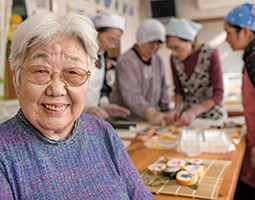Home > Highlighting JAPAN > Highlighting Japan December 2017 > Washoku
Highlighting JAPAN


Futomaki: Celebratory Sushi
The futomaki sushi rolls of Chiba Prefecture are culinary masterpieces that demonstrate the local people’s unique sense of hospitality.
It’s about as close to gastronomical wizardry as you can get.
Tomie Hirano spreads, kneads and fashions rice, green beans, wild burdock, kanpyo (dried gourd strips) and other ingredients on a thin, oblong-shaped omelette, in a controlled display of what appears to be organized chaos.
Then she wraps the salmagundi of ingredients using a makisu bamboo mat, creating a 10-cm thick roll, which she then slices with a knife and, just like magic, from within the rice, veg and seaweed matrix is revealed a colorful butterfly.
Often the skills required to concoct the globe’s most revered culinary delights are seen as a form of art, though in the case of futomaki sushi rolls, it’s the thing produced that’s a veritable masterpiece.
Futomaki, or its longer title, futomaki matsuri sushi (literally, “festive thick roll sushi”) is a traditional type of sushi from the Boso region of northern Chiba Prefecture, about two-hours southeast of Tokyo. Another popular name for the colorful cuisine is e-maki-zushi, or “picture roll sushi.”
Unlike better known sushi varieties, such as chirashi-zushi (rice in a bowl topped with seafood and vegetables), or the nigiri-zushi (finger-shaped sushi) found in supermarkets around the globe, futomaki is distinctly local fare, whose complex technique and catalogue of colorful designs have been handed down since olden times.
“One should think of futomaki as a fortunate conglomeration of ideas conjured up over the years by more erudite farmers’ wives,” says Eiko Ryuzaki, 88, who has penned numerous books on the history and creation process of futomaki and is a former associate professor of Chiba College of Health Science. “Just to come up with these designs would have required more than just a passing understanding of geometry and algebra, which has led me to believe they were started by farmers’ wives whose education continued beyond elementary school.”
In addition to butterflies, more traditional designs vary from cherry blossom and Mt. Fuji to crabs, dragonflies and rabbits. Some of the designs are so intricate that they require considerable time, patience and skill.
According to Ryuzaki, the cuisine dates back around 100 years, but probably has its roots in a variety of rice balls that were prepared for feasts that date back much further.
While Chiba is known for being blessed with an abundance of farm and marine produce — most notably twenty varieties of seaweed — the evolution of futomaki has been inspired by the arrival in the prefecture of such “imported” ingredients as kanpyo, spinach and sakura denbu (dried cod flakes to which pink food coloring is added).
Over the past sixty years, the number of designs has increased as a wider range of produce has become available.
The idea that it be served at feasts, however, remains unchanged. “It has long been served at celebratory occasions, such as the birth of a child and weddings,” Ryuzaki explains, adding that each village would have a communal collection of crockery and cutlery, meaning that even the less affluent families could hold celebrations.
It is also served at funerals, though without any of the bright colors used for other occasions — colors such as red and pink that are more commonly associated with good fortune in Japan.
Also among the more conventional designs are kanji script characters meaning prosperity, longevity and good will, designs that Ryuzaki says are equally complex to create. “People in this area start preparing futomaki about three days before an event, starting with sourcing the rice and seasoning it,” she explains. “I think that alone demonstrates their deep sense of hospitality.”
Traditionally, the rice is “seasoned” not with salt or other such condiments, but sugar, another aspect that displays the original creators’ nous, she says. After rice is cooked, once it is cooled the contained starch causes it to harden, but the addition of sugar slows that hardening process, she explains.
Since Ryuzaki came across futomaki more than seventy years ago, efforts have been made not only to catalogue traditional designs but also create new designs and spread the word of “futomaki” not just in Japan but overseas as well.
“Today there are over 100 designs and we have introduced and taught futomaki making in several countries, including Spain, Germany, Turkey and Australia,” says Yoshiko Minegishi, a fellow researcher of Chiba cuisine and an instructor at a local organization called Hanamiyui that guards and promotes the futomaki tradition. “We hope to broaden knowledge of local cuisine such as this, and in the process deepen understanding of Japan’s rich regional cultures.”
© 2009 Cabinet Office, Government of Japan









